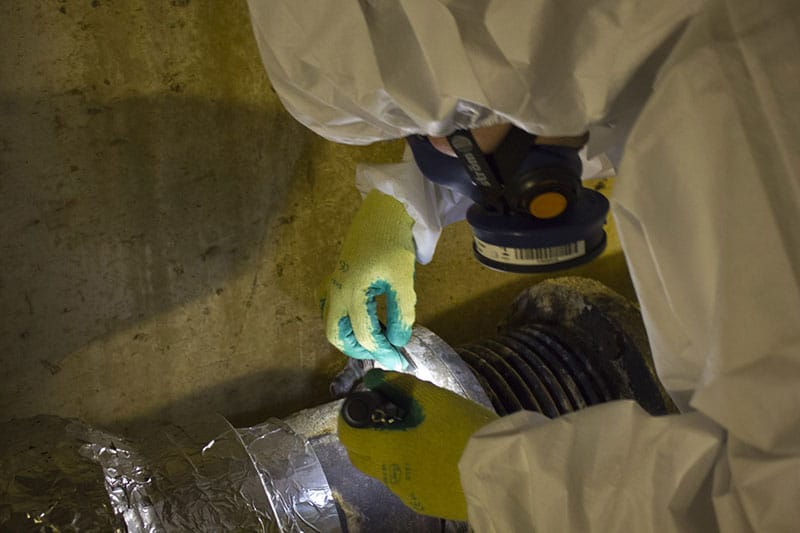How long will asbestos be a problem in the UK?
Asbestos might, in many people’s minds, appear to be a largely “historical” issue, the naturally occurring fibrous silicate mineral not having been legal to import or use in the UK since 1999. However, the ramifications of the material’s once-widespread use in this country are sadly still unfolding.
Moreover, the task of responsibly and safely managing the asbestos that remains in buildings up and down the country, looks set to be a very challenging one for several decades, perhaps even centuries, to come.
Having first been commercially mined in the middle of the 19th century, asbestos came to be especially heavily used in the UK, in sectors such as construction and shipbuilding, from around the 1950s until the 1980s.
But with the substance still being present in significant numbers of commercial, domestic, and public buildings alike, what is the timeframe in which we can expect it to continue posing a problem for building owners, regulators, and the wider public?
For how long will asbestos continue to present problems in the UK?
The short answer to this question, is that no one truly knows. However, estimates in recent years help give a sense of the vast scale of the asbestos problem, even more than a generation after the final ban was handed down on all forms of asbestos in the UK.
While the UK Health and Safety Executive (HSE) has suggested that there could be as relatively few as 210,000 buildings across the country that still contain asbestos, other sources have placed the figure at closer to 1.5 million buildings. The latter figure would reportedly make the UK the European country with the most asbestos per capita.
Similarly, a broad range of timeframes have been put forward in which asbestos could still be an issue in the UK. Realistically, it looks set to continue being a problem for at least decades to come, and it might very likely still be a major issue for another 100 years or so.
The historic legacy of asbestos in buildings
Asbestos was extensively used in the UK for the bulk of the 20th century, chosen on the basis of such factors as its relatively easy availability and affordability, its physical strength, its fire resistance, and its effectiveness as a thermal insulator.
To this day, many UK buildings that were constructed or renovated during that century still contain asbestos-containing materials (ACMs). Examples of these ACMs include – but are by no means limited to – asbestos insulating board (AIB), textured coatings, roofing felt, lagging, and floor tiles.
Only gradually over the course of the 20th century, did it become more widely known that asbestos presented a potentially very serious risk to health in the event of someone ingesting it or breathing it in. The material came to be linked to the development of health conditions such as asbestosis and mesothelioma, which can take several decades to manifest.
Furthermore, ACMs do not necessarily remain in the same condition over time. They can deteriorate or be vulnerable to disturbance, both of which could potentially cause loose asbestos fibres to be released and breathed in by someone nearby.
So, it is clear that for many years and even decades ahead, the asbestos that remains in many “legacy” buildings will require sensitive and well-judged management (and possibly removal).
Dangers posed during renovations and demolitions: unintentional exposure risks
Not only do buildings dating from prior to the 1999 ban often contain very significant quantities of asbestos – thereby necessitating considerable time investment to identify, manage, and safely remove or encapsulate them – but it isn’t necessarily always obvious which materials are ACMs.
This can present particular risks when disruptive activities, such as renovation or demolition work, are taking place in a building – or even a relatively non-disruptive activity, such as everyday maintenance.
When personnel are carrying out such activities in a building, they could be at risk of disturbing materials that they did not even know contained asbestos. This, in turn, could result in accidental exposure to the substance.
Even in situations in which it is known that ACMs are present in given premises – and where those ACMs are located – it is crucial to ensure that safe and responsible practices are followed.
Thorough asbestos surveys can help determine the exact asbestos situation in a given property. This will allow for informed decisions to be made in order to minimise risk, prior to any major activities – such as those outlined above – commencing.
Dangers posed by environmental contamination: a lingering threat
If asbestos is present in a particular building, the risks that it poses are not necessarily limited to the people who directly live and/or work in the given premises, or even those who visit. Asbestos fibres released into the broader environment, for example, can persist for a long time, and pose ongoing risks if they are not properly managed or cleaned up.
The best way to avoid the environment being contaminated with asbestos, of course, is to avoid the improper handling of the material that can lead to this happening in the first place.
The UK today has a stringent regulatory regime in place in relation to how asbestos is managed, including the requirements set out under the Control of Asbestos Regulations 2012 (CAR 2012).
If you are the “dutyholder” for a given property in accordance with CAR 2012 – in other words, the person with the “duty to manage” asbestos on the site – and you are in serious breach of your legal obligations, you could be hit with an unlimited fine, and/or imprisoned for up to two years.
This underlines how crucial it is – from a moral, health, and legal perspective alike – to take proactive steps to monitor and mitigate possible risks to the environment from asbestos in your building.
The long latency period of asbestos: a waiting game
Articles in the media – such as this one about cancer sufferer Barbara Morris, who is believed to have come into contact with asbestos during her time as a sales assistant in the 1970s, but was only diagnosed with her condition five years ago – draw attention to another saddening reality of asbestos disease: its frequently very long latency period.
Someone breathing in or ingesting asbestos is not necessarily an indicator that they will definitely develop asbestos-related disease at a later date. However, such an incident of exposure can elevate a person’s risk of related health problems potentially many decades after the exposure happened.
And as illustrated by The Sunday Times in its story – the newspaper having recently launched a campaign urging the phased removal of asbestos from buildings across the UK – those suffering from asbestos-related disease can experience various ongoing health risks and issues related to their past exposure.
In the case of Ms Morris, this included severe damage to her kidneys from chemotherapy, as well as the removal of her spleen, ovaries, and a layer of her diaphragm.
Challenges in identifying asbestos-containing materials
During the decades ACMs were widely used in construction – and before asbestos’ risks to health became widely known – it was not anticipated by very many people that steps would need to be made, many years later, to manage, remove, and/or encapsulate such materials.
One issue, then, is that ACMs can be hidden away in buildings, and difficult for those other than suitably skilled and experienced asbestos professionals to identify.
This underlines how important it is for a dutyholder for a given premises to engage the services of such asbestos professionals, who will be able to carry out thorough assessments of the building. This will help to ensure anyone who subsequently works on the maintenance, renovation, and/or demolition of the premises is suitably informed, so that they can adopt the appropriate safety measures.
Managing the asbestos problem in the UK
As we referenced above, in the years since the 1999 ban on asbestos, strict regulations have been implemented to assist in the ongoing management of the asbestos problem in the UK.
One requirement stipulated by CAR 2012, for example, is to determine whether there are any materials containing asbestos in given non-domestic premises – and if so, what the location, amount, and condition is of any such materials.
This requirement, in practice, means that an asbestos survey is effectively mandatory in the case of non-domestic buildings dating from before the year 2000.
When the above regulatory obligations are considered alongside advancements over the years in safe asbestos removal practices, it is clear that much has been done in recent times to better control the asbestos situation in UK buildings.
However, it is also of critical importance to avoid complacency. The scope of the asbestos problem remains substantial, and it will likely take a considerable amount of time and resources before we can fully resolve it as a society.
The road ahead: addressing the legacy of asbestos
The Sunday Times’ campaign on asbestos removal helps give a sense of where the political winds are now blowing on the subject of asbestos.
While, back in the 1970s as the health risks of asbestos were only just becoming widely known, the emphasis was on banning the material’s active use in construction, in the 2020s, questions are increasingly being asked about why we are tolerating asbestos still being present in so many buildings, such as schools and hospitals.
The urgency of this mission is being heightened by ever-greater awareness of the evolving risks that “legacy” asbestos materials can present in buildings as they deteriorate in condition.
But of course, even if the goal of complete asbestos removal and/or encapsulation is eventually realised in the UK, considerable time and financial resources will be needed in order to make this happen.
In the present day, the pace of asbestos removal and remediation efforts can depend on available resources, including funding and the availability of trained professionals, and we can expect these to be lingering limiting factors for many years to come.
Conclusion: tackling the UK’s asbestos problem remains a long-term challenge
All in all, the asbestos challenge in the UK remains very much an enduring one. Although much has been done to help control asbestos risks on sites around the UK, the Government – as well as organisations and individuals – will need to stay vigilant in their asbestos management efforts, in order to keep on protecting public health and safety.
Looking at the longer-term picture, ongoing research and developments in asbestos detection and removal technologies may help expedite the process of addressing this longstanding issue.
A future of much-reduced asbestos risk (if not necessarily eliminated asbestos risk) could be within reach within a few generations in the UK. However, the scale of the challenge in reaching this goal – and the probable time and financial investment required for it – must never be underestimated.
Are you interested in finding out more about the UK-wide licensed and accredited asbestos services that Oracle Solutions can provide to help ensure your own peace of mind and regulatory compliance as a dutyholder, as well as safety for building users? If so, please feel free to contact us to ask for your free and fast asbestos quote.

Written by Jess Scott
Jess Scott has been an all-round asbestos consultant since 1996. That’s nearly 3 decades of asbestos knowledge. He spends his time sharing that knowledge with the team at Oracle and with their clients. Jess's goal is, and always has been, to use my expertise in helping people to comply with the law. This legal compliance ultimately helps to protect everyone from the harmful effects of asbestos. Jess has acted as an asbestos expert witness in legal cases and is involved in many asbestos educational activities throughout the UK.

